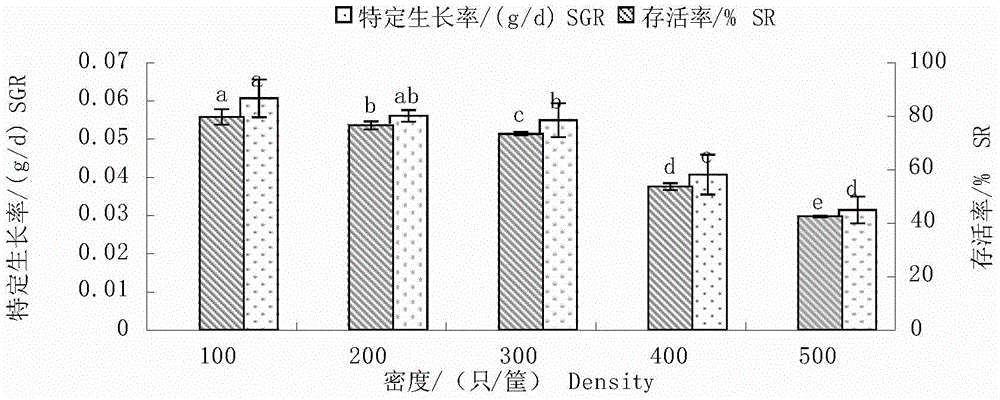Method for cultivating large-size offspring seeds of pharaoh cuttlefish
A tabby squid, large-scale technology is applied in the field of cultivation of tabby squid large-scale seedlings, which can solve problems such as no method for cultivating tabby squid large-scale fry, and achieve clear observation of larvae, simple and feasible operation, and rapid growth of larvae. Effect
- Summary
- Abstract
- Description
- Claims
- Application Information
AI Technical Summary
Problems solved by technology
Method used
Image
Examples
Embodiment 1
[0032] A method for cultivating large-scale seed of tiger squid, the concrete steps are as follows:
[0033] (1) Preliminary training
[0034] Put the tiger squid larvae with a length of 0.6-1.0 cm just out of the membrane in a circular plastic screen basket floating on the water surface of the cement pool, at a water temperature of 22°C, a salinity of 24, a dissolved oxygen of 4mg / L, and a breeding density of 100 / basket Under the condition of 8 days, live mysis was fed daily during the cultivation process, feeding twice a day, the daily feeding amount was 14% of the body weight of tiger squid larvae, and the water was changed once a day, and the water exchange amount was 50%; The sieve hole diameter of the circular plastic sieve basket is 0.1cm, and the color is blue;
[0035] (2) Mid-term training
[0036] Move the tiger squid larvae whose carcass length is greater than 1.0cm and less than 3.0cm to a cement pond for cultivation, at a water depth of 60cm, at a water tempera...
Embodiment 2
[0040] With embodiment 1, its difference is:
[0041] (1) Preliminary training
[0042] Under the conditions of water temperature 24°C, salinity 30, dissolved oxygen 10mg / L, and breeding density 200 / basket, cultured for 10 days; during the cultivation process, daily feeding of strengthened artemia nauplii, daily feeding amount of tiger squid 8% of the body weight of the larvae; the sieve hole diameter of the circular plastic sieve basket is 0.3cm, and the color is red;
[0043] (2) Mid-term training
[0044] At a water depth of 70cm, a water temperature of 25°C, a salinity of 22, a dissolved oxygen of 8mg / L, and a breeding density of 500 / m2 Under the condition of 28 days, live mysis was fed daily during the cultivation process, 2 times a day, the daily feeding amount was 15% of the body weight of tiger squid larvae, and the water was changed 2 times a day;
[0045] (3) Later cultivation
[0046] At a water depth of 100cm, a water temperature of 25°C, a salinity of 29, a ...
Embodiment 3
[0048] With embodiment 1, its difference is:
[0049] (1) Preliminary training
[0050] Under the conditions of water temperature 27°C, salinity 33, dissolved oxygen 20mg / L, and breeding density 300 / basket, culture for 12 days; feed twice a day during the culture process, and the daily feeding amount is 12% of the body weight of tiger squid larvae; The sieve hole diameter of the circular plastic sieve basket is 0.5cm;
[0051] (2) Mid-term training
[0052] At a water depth of 80cm, water temperature 22°C, salinity 24, dissolved oxygen 20mg / L, breeding density 700 / m 2 Under the condition of 35 days, feed was fed twice a day during the cultivation process, and the daily feeding amount was 17% of the body weight of tiger squid larvae;
[0053] (3) Late cultivation
[0054] At a water depth of 120cm, a water temperature of 27°C, a salinity of 33, a dissolved oxygen of 20mg / L, and a breeding density of 200 / m 2 Under the condition of 30 days, the seed culture was completed, ...
PUM
| Property | Measurement | Unit |
|---|---|---|
| Diameter | aaaaa | aaaaa |
| Depth | aaaaa | aaaaa |
| Mesh diameter | aaaaa | aaaaa |
Abstract
Description
Claims
Application Information
 Login to View More
Login to View More - R&D Engineer
- R&D Manager
- IP Professional
- Industry Leading Data Capabilities
- Powerful AI technology
- Patent DNA Extraction
Browse by: Latest US Patents, China's latest patents, Technical Efficacy Thesaurus, Application Domain, Technology Topic, Popular Technical Reports.
© 2024 PatSnap. All rights reserved.Legal|Privacy policy|Modern Slavery Act Transparency Statement|Sitemap|About US| Contact US: help@patsnap.com










